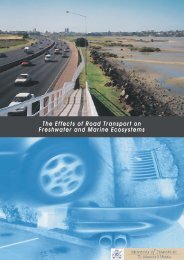Auckland City Centre Rail Link - Business Case Review - Ministry of ...
Auckland City Centre Rail Link - Business Case Review - Ministry of ...
Auckland City Centre Rail Link - Business Case Review - Ministry of ...
You also want an ePaper? Increase the reach of your titles
YUMPU automatically turns print PDFs into web optimized ePapers that Google loves.
<strong>Auckland</strong> <strong>City</strong> <strong>Centre</strong> <strong>Rail</strong> <strong>Link</strong> <strong>Business</strong> <strong>Case</strong> <strong>Review</strong> | May 2011<br />
A single lane <strong>of</strong> motorway<br />
Bus lanes<br />
Dedicated busway<br />
Dedicated light rail<br />
<strong>Auckland</strong>‘s rail corridors<br />
Capacity per Hour<br />
2,400 people<br />
7,500 people<br />
12,000 people<br />
12,000 people<br />
20,000 – 25,000 people<br />
Up to 2016, the current rail upgrade will enable electrification <strong>of</strong> the network and<br />
achieve 10 minute frequencies on each rail corridor. The electrification business case<br />
identified a strategic benefit <strong>of</strong> electrification is that it enables future expansion <strong>of</strong> the<br />
rail network including the underground <strong>City</strong> <strong>Centre</strong> <strong>Rail</strong> <strong>Link</strong> (CCRL).<br />
However, without the CCRL the future development <strong>of</strong> the city centre will be<br />
compromised by its constrained transport network making it harder for people, goods<br />
and services to get to and around the city centre to do business and access its<br />
international economic, education, cultural and tourist opportunities.<br />
The constraint in the roading network has already occurred with most approaches<br />
to the city centre at or near capacity in the peak periods.<br />
The bus network is already under pressure with significant constraints occurring<br />
from 2014 along Symonds Street and from 2016 along Albert Street.<br />
The constraint in the rail network occurs in 2016.<br />
As these constraints come into play and become more severe, the city centre will<br />
suffer in economic terms and without a clear commitment to resolve these constraints<br />
with the CCRL, investment in the city centre will be deferred.<br />
<strong>Auckland</strong>‘s rapid transit future includes both rail and buses doing what they are most<br />
efficient at doing and constraints in the network will require both bus and rail<br />
solutions. <strong>Rail</strong> is better than buses at addressing traffic congestion in the <strong>Auckland</strong><br />
isthmus congested transport corridors because the established rail corridors provide<br />
separate rights <strong>of</strong> way unaffected by road congestion and have significant spare<br />
capacity once the Britomart constraint is released. Furthermore, initial indications are<br />
that the <strong>Auckland</strong> Plan envisages land use development being concentrated around<br />
stations.<br />
The bulk <strong>of</strong> the Central <strong>City</strong> is not within<br />
walking distance <strong>of</strong> current stations<br />
The bulk <strong>of</strong> the Central <strong>City</strong> will be within<br />
walking distance <strong>of</strong> current stations once the<br />
Central <strong>City</strong> link is constructed<br />
28
















